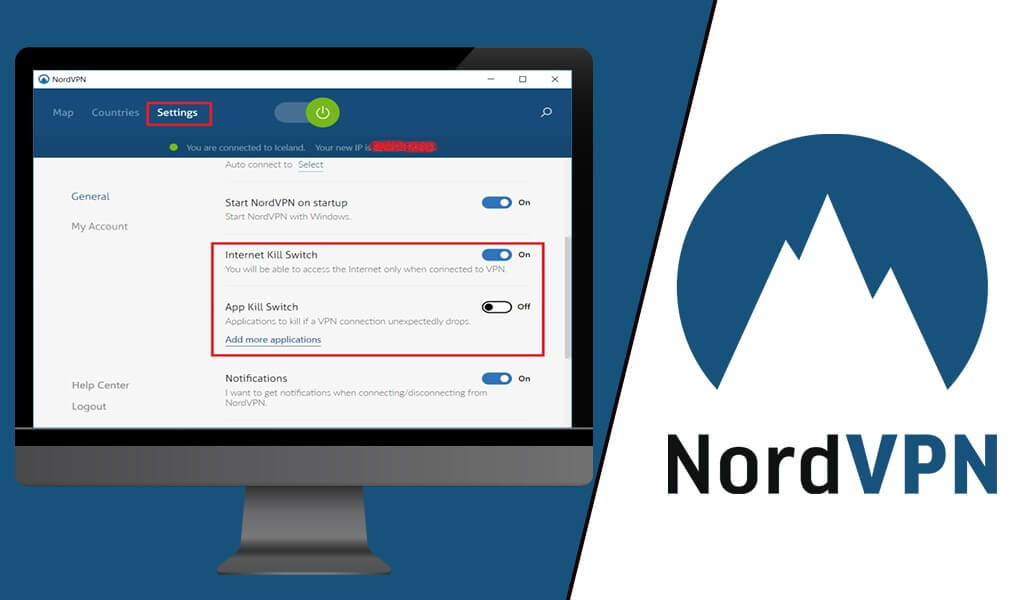If you’re a VPN user, you are likely aware of kill switches. Kill switches are an important security feature built into many VPNs, allowing you to remain anonymous and protected in the event of a sudden connection termination.
NordVPN users may be wondering how to use the kill switch feature that comes with NordVPN. In this article, we’ll explain what the kill switch does, why you should use it, and how to enable it so you can stay safe online.
How Do Kill Switches Work?
VPNs, as you are likely aware, protect your privacy online by encrypting your Internet traffic through a separate server, masking your real IP address and identity. This prevents the websites and other services you access from finding out who you are.
However, VPNs have technical problems, just like any other computer hardware or software. They sometimes go offline due to scheduled maintenance or unexpected glitches. If your VPN connection is disrupted while you are online, your device will automatically switch back to your regular, unencrypted connection, exposing your identity.
A kill switch guards against this. When a VPN kill switch is enabled, your VPN will automatically terminate your Internet connection entirely should your VPN connection be disrupted in any way. This will keep you protected should something happen to your VPN.
Kill switches are extremely useful in a number of different situations. For example, if you are using a torrent client, enabling your VPN’s kill switch feature is key because if you don’t, your client will continue downloading torrents even if your VPN is disconnected. A kill switch will stop all torrent downloads, keeping your real identity safe.
NordVPN’s Kill Switch: How it Works
While many VPNs offer a kill switch feature, NordVPN offers three different types of kill switches: an automatic Internet kill switch, a more restrictive version of the Internet kill switch, and an app kill switch.
The Internet kill switch is the standard, default kill switch and is similar to other VPN kill switches. When enabled, it will automatically terminate your Internet connection should your VPN connection drop.
The restrictive version of the Internet kill switch will terminate your Internet traffic not only if the VPN connection drops unexpectedly, but when you turn the VPN off yourself. This is useful if you want a reminder to always enable your VPN when torrenting or doing other types of activities on the Internet.
Finally, the app kill switch will only terminate Internet traffic to selected programs on your device, allowing other apps to continue working over an unprotected connection. This is useful if you only want to stop traffic to individual programs, such as torrent clients.
While NordVPN offers some form of kill switch for all clients on all platforms, not all of the three aforementioned kill switches may be available on every platform.
How to Enable NordVPN’s Kill Switch
NordVPN’s kill switch can be enabled from any client on any device, though the steps are slightly different depending on which client. Generally, however, you can turn the kill switch on by going to the Settings menu and selecting the “Kill Switch” option.
The two biggest differences when it comes to NordVPN’s kill switch are when it comes to Android and iOS devices. In the case of the latter, the kill switch is always on by default and can’t be turned off, so you’re always protected so long as your VPN is enabled.
When it comes to Android devices, kill switch functionality can be found in the Connections menu of your phone’s settings while connected to NordVPN. Selecting “More Connection Settings,” then selecting “VPN,” “NordVPN,” and “Always On” will implement a system-wide kill switch for your device.
Note that in some rare cases, NordVPN’s kill switch may not work properly. This most often occurs when using a protocol other than OpenVPN. To fix this, switch your protocol to OpenVPN.
Is it Worth Using NordVPN’s Kill Switch?
NordVPN has a reputation for reliability and consistency, so it’s rare for NordVPN users to experience connection issues. However, as with any Internet connection, disconnections can happen. Should your VPN connection be interrupted, your real identity will be revealed to the wider Internet, which represents a security risk, particularly if you are torrenting or engaged in other types of activities.
Because of this, we recommend using NordVPN’s kill switch feature, even if you aren’t interested in torrenting or similar activities. While NordVPN is a trustworthy and reliable VPN service, using the kill switch gives you an added layer of protection in the event of a malfunction.
Moreover, NordVPN’s kill switch doesn’t come with any additional fees; it’s free and comes with your NordVPN client. This means that you can set up the kill switch with no downsides of any kind.
The fact that NordVPN offers multiple kill switches also gives you maximum flexibility when it comes to your Internet usage. Using its restrictive kill switch is handy if you want to keep yourself from accidentally torrenting without turning your VPN, for example.
NordVPN’s app kill switch is also very useful if you only want to terminate Internet traffic to individual programs. As mentioned earlier, you can stop Internet traffic to, for example, your torrent client while keeping other programs active.
Overall, we recommend using NordVPN’s kill switch for added security when you go online. It gives you a guarantee of privacy with little in the way of risk.
NordVPN’s Kill Switch: The Bottom Line
Kill switches are an important feature when it comes to using VPNs. They allow you to maintain your privacy in the event your VPN unexpectedly disconnects, preventing your real IP address from being exposed to the wider Internet.
By using the steps in this guide, you’ll be able to configure NordVPN’s kill switch, giving you added protection when you go online. Regardless of how you use your VPN, you’ll find that kill switches are a useful and handy feature for protecting your anonymity.

